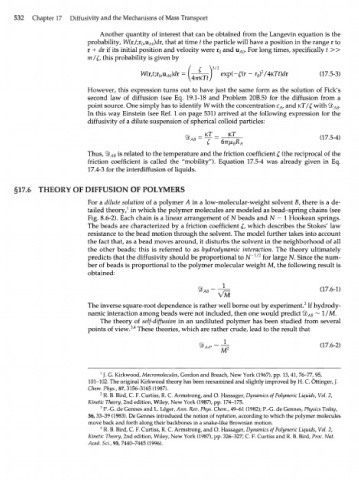Page 552 - Bird R.B. Transport phenomena
P. 552
532 Chapter 17 Diffusivity and the Mechanisms of Mass Transport
Another quantity of interest that can be obtained from the Langevin equation is the
probability, W(r,t',Y ,\i )di, that at time t the particle will have a position in the range r to
0
A0
r + dx if its initial position and velocity were r and и . For long times, specifically t »
ло
0
ra/£, this probability is given by
( -^jA \ 3/ 2 exp(-£(r - r o) /4KTt)dr (17.5-3)
I
2
However, this expression turns out to have just the same form as the solution of Fick's
second law of diffusion (see Eq. 19.1-18 and Problem 20B.5) for the diffusion from a
point source. One simply has to identify W with the concentration c A, and кТ/£ with ЯЬ .
АВ
In this way Einstein (see Ref. 1 on page 531) arrived at the following expression for the
)
diffusivity of a dilute suspension of spherical colloid particles: (1754
^к --
Thus, ЯЬ is related to the temperature and the friction coefficient £ (the reciprocal of the
АВ
friction coefficient is called the "mobility"). Equation 17.5-4 was already given in Eq.
17.4-3 for the interdiffusion of liquids.
§17.6 THEORY OF DIFFUSION OF POLYMERS
For a dilute solution of a polymer Л in a low-molecular-weight solvent B, there is a de-
1
tailed theory, in which the polymer molecules are modeled as bead-spring chains (see
Fig. 8.6-2). Each chain is a linear arrangement of N beads and N — 1 Hookean springs.
The beads are characterized by a friction coefficient £, which describes the Stokes' law
resistance to the bead motion through the solvent. The model further takes into account
the fact that, as a bead moves around, it disturbs the solvent in the neighborhood of all
the other beads; this is referred to as hydrodynamic interaction. The theory ultimately
1/2
predicts that the diffusivity should be proportional to N~ for large N. Since the num-
ber of beads is proportional to the polymer molecular weight M, the following result is
obtained:
Э ~ - 7 = (17.6-1)
А В
VM
The inverse square-root dependence is rather well borne out by experiment. If hydrody-
2
namic interaction among beads were not included, then one would predict 0) ~ 1 /M.
лв
The theory of self-diffusion in an undiluted polymer has been studied from several
3 4
points of view. ' These theories, which are rather crude, lead to the result that
2 W , ~ - ^ 07.6-2)
J. G. Kirkwood, Macromolecules, Gordon and Breach, New York (1967), pp. 13,41, 76-77, 95,
1
101-102. The original Kirkwood theory has been reexamined and slightly improved by H. С Ottinger, /.
Chem. Phys., 87, 3156-3165 (1987).
R. B. Bird, C. F. Curtiss, R. C. Armstrong, and O. Hassager, Dynamics of Polymeric Liquids, Vol. 2,
2
Kinetic Theory, 2nd edition, Wiley, New York (1987), pp. 174-175.
3
P.-G. de Gennes and L. Leger, Ann. Rev. Phys. Chem., 49-61 (1982); P.-G. de Gennes, Physics Today,
36, 33-39 (1983). De Gennes introduced the notion of reptation, according to which the polymer molecules
move back and forth along their backbones in a snake-like Brownian motion.
4
R. B. Bird, C. F. Curtiss, R. C. Armstrong, and O. Hassager, Dynamics of Polymeric Liquids, Vol. 2,
Kinetic Theory, 2nd edition, Wiley, New York (1987), pp. 326-327; C. F. Curtiss and R. B. Bird, Proc. Nat.
Acad. Sci., 93, 7440-7445 (1996).

